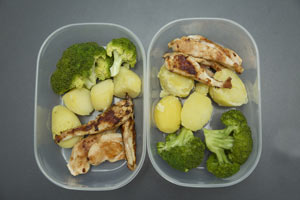 A healthy diet is an important component in maintaining a healthy lifestyle, but regular exercise may be the key to living a long healthy life.
A healthy diet is an important component in maintaining a healthy lifestyle, but regular exercise may be the key to living a long healthy life.
Everyone knows that exercise is important. But many people struggle with consistently fitting it into their daily routine. Starting and stopping a workout program is not going to cut it when it comes to improving your overall health. You must make a commitment to exercise regularly throughout your life. It should be part of your daily routine that just naturally becomes a habit (think brushing your teeth).
Forming a new habit
A habit (good or bad) is something you do without thinking. It’s definitely not something you squeeze in when you have the time or something you come up with excuses to skip now and then. You probably won’t ever hear someone say they were going to bite their nails this morning, but they overslept.
Most habits are pick up unconsciously as we go about our daily lives, but it’s possible to consciously form a new habit through repetition and routine.
Do it again and again
We get up when out alarm goes off, take a shower, eat breakfast, brush our teeth and leave for work. We repeat these small tasks day after day, and for most people, there’s not a whole lot of thought or planning to it. That’s because after years of repetition, these things have become small habits that are part of our daily routine.
To make exercise one of those habits, we need to treat it just like any other task that we consider critical to our daily routine.
When can you realistically workout?
The first thing to do is decide on a time of day for exercising, as this could impact where you are able to exercise and what type of exercise you’ll be able to do.
For example, if you know you’ll have more time in the morning but need to be home to get the kids up for school, going to the gym wouldn’t be a good option. Instead, opt for an hour of yoga at home, or invest in a treadmill or other home equipment so you can check your workout off your to-do list first thing in the morning.
Where’s the best location?
If you’re able to schedule your workout for a time of day that allows you to be out of the house, it’s still important to consider where your workout will take place. Try to make it a convenient location, such as near your work or home. That way you’ll limit the amount of excuses you make for not getting there.
What’s your preferred workout?
Choosing the type of activity you’ll do for your daily workout is one of the most critical components to creating a habit. If you try something new and don’t like it, give it a week or two before giving up. But if you still dread it, move on to something else.
Don’t be discouraged if this happens a few times. Eventually you’ll find what works for you, and once you do, you’ll know it right away.
For more articles go to http://lifesportfitness.lifestyleezine.com

 Improvements in medical care and increased knowledge of the importance of good nutrition and exercise have many individuals seeking ways to live a longer and healthier life. While this is good news, there also seems to be an increase in previously uncommon health conditions, such as
Improvements in medical care and increased knowledge of the importance of good nutrition and exercise have many individuals seeking ways to live a longer and healthier life. While this is good news, there also seems to be an increase in previously uncommon health conditions, such as  Some people are just naturally happy. These are the people you always see smiling even when the weather is bad or who never seem phased by any major changes in the workplace.
Some people are just naturally happy. These are the people you always see smiling even when the weather is bad or who never seem phased by any major changes in the workplace. If you have ever had water leaking from a pipe or seeping into your basement, you may be familiar with how quickly tiny mold spores can form. But many people aren’t aware that those tiny molecules can actually make you very sick.
If you have ever had water leaking from a pipe or seeping into your basement, you may be familiar with how quickly tiny mold spores can form. But many people aren’t aware that those tiny molecules can actually make you very sick. Advancements in technology have made instant access to information and communication part of our daily lives. Although such advancements were intended to make things easier, some argue that technology has made us lazier and has hampered basic communication skills.
Advancements in technology have made instant access to information and communication part of our daily lives. Although such advancements were intended to make things easier, some argue that technology has made us lazier and has hampered basic communication skills. They are inexpensive and convenient, and they are in practically everyone’s kitchen. But those seemingly helpful plastic containers commonly used for storing food could pose serious health risks.
They are inexpensive and convenient, and they are in practically everyone’s kitchen. But those seemingly helpful plastic containers commonly used for storing food could pose serious health risks. Our immune systems are supposed to protect us against bacteria and viruses that may cause infections or diseases. Although the occurrence is somewhat rare, every now and then a person’s immune system becomes confused, allowing healthy tissues to come under attack. The occurrence of this strange phenomenon is known as an autoimmune disease.
Our immune systems are supposed to protect us against bacteria and viruses that may cause infections or diseases. Although the occurrence is somewhat rare, every now and then a person’s immune system becomes confused, allowing healthy tissues to come under attack. The occurrence of this strange phenomenon is known as an autoimmune disease. Many of today’s popular diet trends promise quick fixes for all sorts of issues, with the most popular being easy weight loss. So how is clean eating any different?
Many of today’s popular diet trends promise quick fixes for all sorts of issues, with the most popular being easy weight loss. So how is clean eating any different? If you have been attempting to shed a few pounds, focusing on all the things you can’t or shouldn’t eat may have you may feeling a bit deprived. Instead, try focusing on the healthy, fat-burning options you should actually be enjoying more of.
If you have been attempting to shed a few pounds, focusing on all the things you can’t or shouldn’t eat may have you may feeling a bit deprived. Instead, try focusing on the healthy, fat-burning options you should actually be enjoying more of.